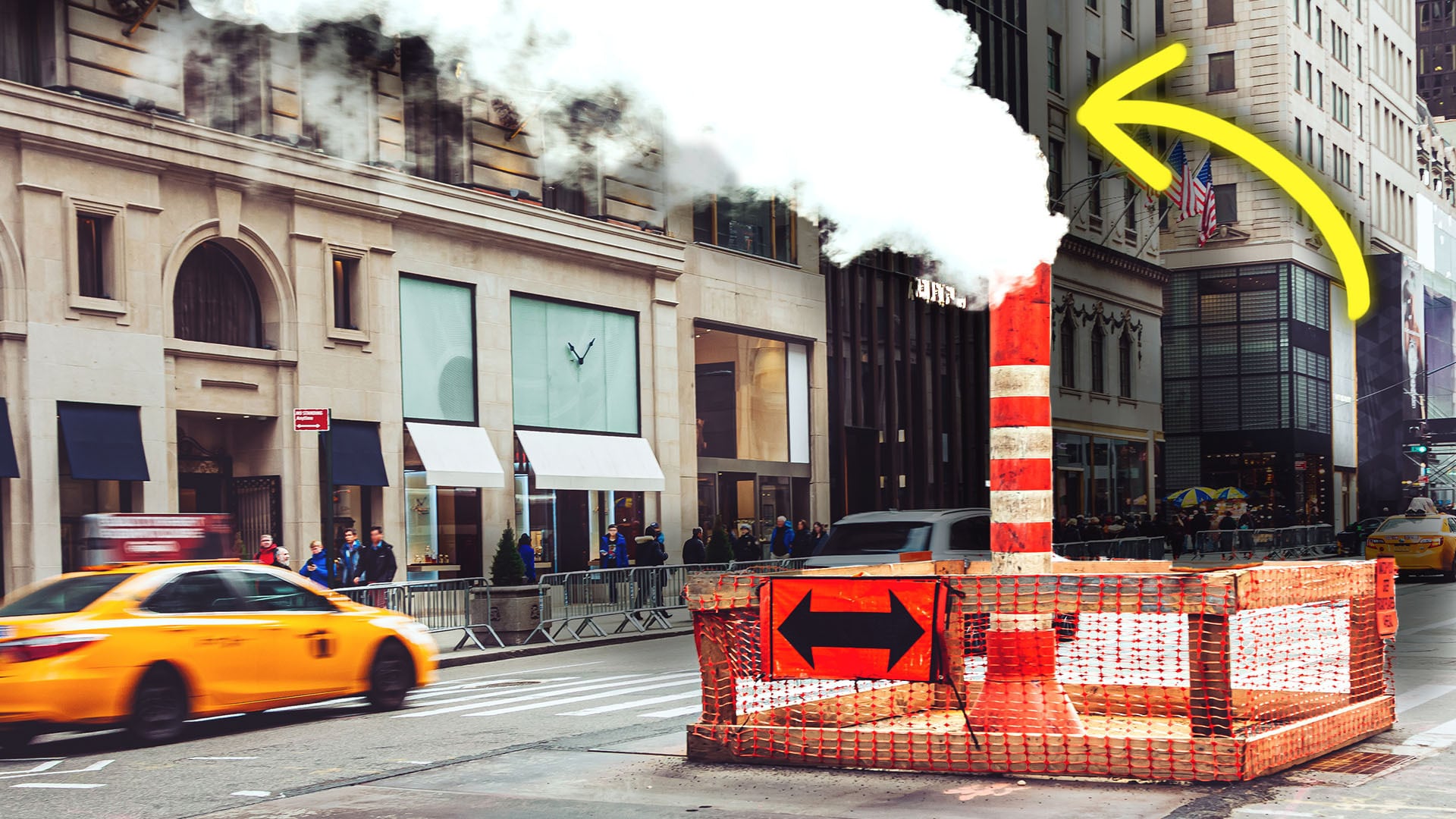Seeing manholes with plumes billowing or tall white and orange pipes with exhaust blowing out may be commonplace for New Yorkers but it's not widely known why this happens all over the Big Apple.
For a city with such strict regulations on emissions and idling engines, those white puffs filling the air might raise a few questions, but it's the result of a process that is perhaps one of New York City's most intriguing infrastructure stories. And it has to do with maintaining temperature in its largest buildings.
That white fog you see coming from the ground isn't some toxic cloud but rather steam that was flowing through a cracked pipe underground. That same steam is used to service buildings with heat, cool air, and even humidity for art museums looking to preserve artifacts.

The city began implementing the use of steam on a large scale in the 1880s after inventor Birdsill Holly figured out how to heat his entire home using a large boiler with pipes that could distribute the heat throughout the home.
Steam Heating Transforms NYC
The use of steam for heating homes at this point was not out of the ordinary but the price tag on the technology made it a less than desirable option. Typically, people were using coal stoves and fireplaces but the heat was limited to a confined area. Holly's idea to connect pipes to a large boiler to distribute heat evenly around the house would mark a turning point.
With his newly-founded Holly Steam Combination Company, he went on to create the first community-wide steam heating system in Lockport, N.Y., in 1877. It would go on to lay the blueprint for the massive steam system that exists in New York City today.
Just five years after Holly's Lockport heating installation, the New York Steam Company owned by Wallace C. Andrews opened for business and by 1882 served 62 customers. That number jumped to 350 by 1866.
At the time, the New York Steam Company operated on just five miles of piping in lower Manhattan, stretching a few blocks from its plant, which was located in the area where the World Trade Center stands.
For private residences outside of the city, coal-fired heating was still the optimal choice, but the introduction of steam heating in commercial buildings was industry-altering. Now, skyscrapers like the Empire State Building, which began construction in 1930, would have means to heat the very top of the building without installing its own coal-fired boiler system in the basement.
Today, the network sprawls over 100 miles of complex piping under Manhattan and draws its energy from six different plants in Manhattan, Queens, and Brooklyn. The system functions as natural gas is burned to spin turbines that generate electricity, then the pressurized gas is redistributed to warm boilers to make steam.
The process is known as cogeneration.
"What's key about steam is that it could provide heating to buildings that were taller because up until the 1860s, New York just didn't have any buildings that were taller than just a few feet. So one big boiler in the basement would be fine, but as buildings got taller, you would have to build bigger and bigger boilers and that was just kind of impossible," Greg Young, a researcher and podcaster at the Bowery Boys, told Cheddar.
ConEd Emerges in NYC
The emerging energy industry in New York City opened up and while competitors battled for business, companies like New York Steam Company and The Edison Electric Illuminating Company also worked together on public service projects. By 1935, these companies and several other utilities combined over the years, forming Consolidated Edison, better known today as ConEd, one of the largest power companies in the U.S.
The flourishing system did not come without its own set of problems and has sparked debate around whether steam should be swapped out for natural gas.
Michael Tobias, the founder at New York Engineers, told Cheddar the orange and white striped chimneys that dot city streets are dealing with a relatively small leak and are generally safe to walk by. But when the leak becomes bigger, that's when an explosion can happen.
Corrosion can cause pipes to develop tiny holes that expand over time allowing steam to escape and can cause catastrophic failures in some instances. Steam pipes are also susceptible to 'water hammers,' which occur when cooler liquid water ends up flowing with steam through piping.
"If you've got steam moving through a pipe under the ground and it suddenly picks up a slug of water, which is not compressible, that water is going to be like a cannonball. And when it gets to an intersection and has to make a 90-degree turn, that slug of water has the power to break that pipe at the corner, and that happens. And when that happens, it blows up the entire intersection," Dan Holohan, author of The Lost Art of Steam Heating, told Cheddar.
As recently as 2018, there was a massive steam pipe explosion in the Flatiron District of Manhattan, that blasted an asbestos-filled cloud into the sky. No one died in the blast, but the area had to be evacuated for several days due to the toxic plume.
In 2007, one person was killed and 30 others were injured when a pipe laid in 1924 exploded near Grand Central Station as the result of a water hammer.
While the debate continues over whether the city should swap out steam for natural gas, steam remains a more sustainable option, particularly after newly implemented local laws placed limits on the emissions large buildings are able to release.
"Because it's cogeneration, there's going to be a carbon advantage to heating the building with steam. There will be a real dollar value," Tobias said.



